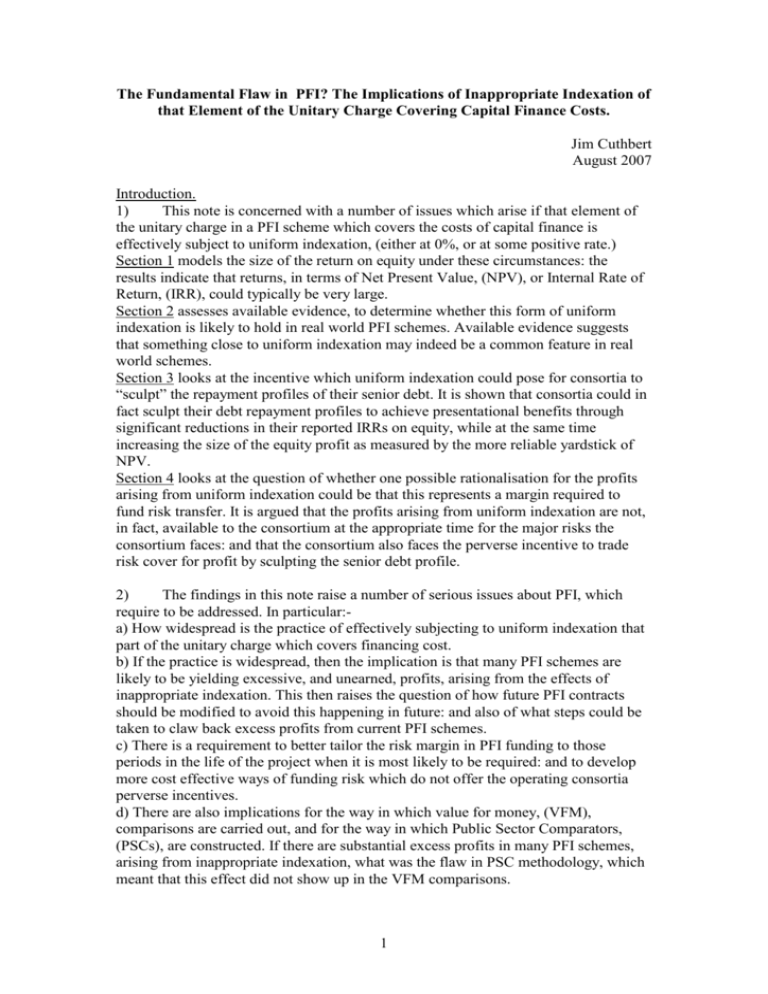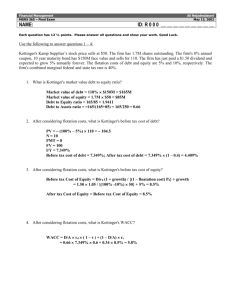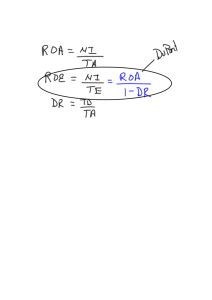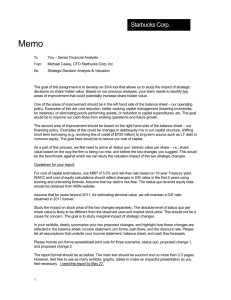this paper - Jim Cuthbert and Margaret Cuthbert
advertisement

The Fundamental Flaw in PFI? The Implications of Inappropriate Indexation of that Element of the Unitary Charge Covering Capital Finance Costs. Jim Cuthbert August 2007 Introduction. 1) This note is concerned with a number of issues which arise if that element of the unitary charge in a PFI scheme which covers the costs of capital finance is effectively subject to uniform indexation, (either at 0%, or at some positive rate.) Section 1 models the size of the return on equity under these circumstances: the results indicate that returns, in terms of Net Present Value, (NPV), or Internal Rate of Return, (IRR), could typically be very large. Section 2 assesses available evidence, to determine whether this form of uniform indexation is likely to hold in real world PFI schemes. Available evidence suggests that something close to uniform indexation may indeed be a common feature in real world schemes. Section 3 looks at the incentive which uniform indexation could pose for consortia to “sculpt” the repayment profiles of their senior debt. It is shown that consortia could in fact sculpt their debt repayment profiles to achieve presentational benefits through significant reductions in their reported IRRs on equity, while at the same time increasing the size of the equity profit as measured by the more reliable yardstick of NPV. Section 4 looks at the question of whether one possible rationalisation for the profits arising from uniform indexation could be that this represents a margin required to fund risk transfer. It is argued that the profits arising from uniform indexation are not, in fact, available to the consortium at the appropriate time for the major risks the consortium faces: and that the consortium also faces the perverse incentive to trade risk cover for profit by sculpting the senior debt profile. 2) The findings in this note raise a number of serious issues about PFI, which require to be addressed. In particular:a) How widespread is the practice of effectively subjecting to uniform indexation that part of the unitary charge which covers financing cost. b) If the practice is widespread, then the implication is that many PFI schemes are likely to be yielding excessive, and unearned, profits, arising from the effects of inappropriate indexation. This then raises the question of how future PFI contracts should be modified to avoid this happening in future: and also of what steps could be taken to claw back excess profits from current PFI schemes. c) There is a requirement to better tailor the risk margin in PFI funding to those periods in the life of the project when it is most likely to be required: and to develop more cost effective ways of funding risk which do not offer the operating consortia perverse incentives. d) There are also implications for the way in which value for money, (VFM), comparisons are carried out, and for the way in which Public Sector Comparators, (PSCs), are constructed. If there are substantial excess profits in many PFI schemes, arising from inappropriate indexation, what was the flaw in PSC methodology, which meant that this effect did not show up in the VFM comparisons. 1 e) Given that the IRR on equity can be manipulated by sculpting senior debt profiles, then it is important to avoid falling in to the trap of summarising the performance of PFI schemes by quoting crude IRRs. Section 1: Modelling the return from uniform indexation of the capital financing element of the unitary charge. 1.1) One of the elements which has to be funded out of the unitary charge in a typical PFI scheme is the cost of servicing the senior debt used to finance the scheme. Senior debt service charges will typically represent a declining profile over the life of the project: for example, the lower line in Chart 1 shows the profile of debt service charges, (that is, interest charges plus repayments), for a loan of £9 million at 6% interest over 30 years, where the loan is on an equal repayment basis. 1.2) Senior debt will typically represent about 90% of the capitalisation of a PFI project: the other 10% being akin to equity. Suppose that, for a £10 million project, the capital finance element of the unitary charge in year 1 was worked out as if the whole project had been financed at 6% interest: and suppose that this element of the unitary charge was maintained constant throughout the life of the project: this is the flat upper line in Chart 1. If this was done, then the increasing wedge between the lower and upper lines in Chart 1 would be available to reward the equity funders, (after payment of an amount of tax which would depend on the breakdown of the 10% “equity” component into subordinate debt and true equity.) If the cost of capital element of the unitary charge was subject to any degree of positive indexation, then the rewards to the equity holders would be that much larger. Chart 1: Senior Debt Service on £10m Project, Compared with Flat Uprate of Year 1 Capital Charge 1 0.9 Year 1 Capital Charge, with flat uprate 0.8 0.7 0.6 Senior Debt Service 0.5 0.4 0.3 0.2 0.1 30 29 28 27 26 25 24 23 22 21 20 19 18 17 16 15 14 13 12 11 9 10 8 7 6 5 4 3 2 1 0 1.3) This section is concerned with quantifying the returns to equity under this type of situation. More formally, the following situation was modelled. The project is assumed to involve a capital asset with life 30 years. For simplicity, the cost of the capital asset is taken to be 10. It is assumed that 90% of the cost of the capital asset is 2 funded by senior debt, in the form of an equal repayment loan over 30 years, at interest rate i: hence the senior debt service charge in year k of the project would be 1 i(31- k) 9( + ) (1) 30 30 Now looking at the unitary charge, it is assumed that the year 1 element of the unitary charge to cover financing costs is calculated as if the whole of the cost of the project is financed at interest rate i. This element of the unitary charge is then uprated by an annual factor u: so the financing element of the unitary charge in year k is then 1 10( + i)(1 + u) k-1 (2) 30 The initial equity input to the project is 1: and the difference between formula 2 and formula 1 is then available as the nominal, pre tax return on this unit equity input. The value of this series of returns on equity was then expressed in two different ways: a) as an NPV figure, (discounted at 6% nominal): b) as a nominal, pre tax IRR on the initial equity input. 1.4) Tables 1 and 2 show the NPV and IRR respectively, for interest rate i = 6%, 7% and 8%, and unitary charge uprate factor u = 0%, 1.5% and 3%. Table 1: Net Present Values of Equity Returns Annual Uprate % on Unitary Charge Interest Rate % 0% 1.5% 3.85 6.10 6% 4.41 6.90 7% 4.98 7.71 8% 3% 8.96 10.08 11.19 Table 2: Internal Rate of Return on Equity Annual Uprate % on Unitary Charge Interest Rate 0% 1.5% 18.6 23.3 6% 20.3 25.1 7% 22.0 26.8 8% 3% 27.3 29.2 31.1 1.5) As the Tables show, the nominal pre tax returns on equity under these scenarios are very considerable: even in the least generous case considered, (6% interest, and 0% uprate factor on the unitary charge), the NPV of the sequence of equity returns is 3.85, and the IRR on equity is 18.6%. Remembering that the equity input is 1, this means that the present value of the equity reward stream is almost 4 times the equity input. For the most generous case considered, the rewards are huge: an NPV of over 11, and an IRR of 31.1%. Note too that the uprate factor u operates on the returns to equity with a significant gearing effect: a 1.5 percentage point increase in u typically increases the IRR on equity by almost 5 percentage points. Section 2: Evidence on Indexation Practices on the Financing Component of the Unitary Charge. 3 2.1) Is there any evidence that real world PFI schemes actually do behave at all like the situation described in Section 1? There is a lot of evidence that the unitary charge schemes for many PFI projects are governed by simple uprating rules: typically, the unitary charge will be split into tranches, with the different tranches subject to different uprating rules, perhaps some in line with projected inflation, some at half the inflation rate, and some at 0%. This type of evidence, however, is not enough to confirm that that part of the unitary charge which covers financing costs is subject to a simple uprating rule. The reason for this is that, within an overall unitary charge being uprated by some simple rule, projected spend on providing physical services, like lifecycle and maintenance expenditure, may be growing in such a way that the residual cash flow available to cover financing, tax and profit, (called the pre-finance, pre-tax cash flow, denoted PFPTCF), could be declining. It is therefore necessary to establish how PFPTCF is projected to grow within the overall unitary charge: the pattern of interest would be where PFPTCF starts off at a level which is above the initial level of senior debt service charges, and where PFPTCF is then effectively subject to some uniform form of indexation. Information like this is not easy to come by, since projections of the different components of expenditure within the unitary charge are normally covered by commerciality in confidence restrictions. However, some important evidence is available. 2.2) One piece of hard evidence is given by the financial projections prepared by the consortium responsible for one particular PFI hospital in England: (it should be noted that such projections are not normally publicly available.) Chart 2, taken from these financial projections, shows the overall projected unitary charge, and within that, PFPTCF, and senior debt service charges. The difference between the unitary charge and PFPTCF lines represents the consortium’s projections for what will be required for operations and maintenance: the difference between PFPTCF and senior debt service represents the pre-tax nominal reward for equity. The picture presented in the Chart is interesting: after an initial wobble, the unitary charge grows by being indexed at 3%: (the trend line showing constant growth is also shown on the Chart). Operations and maintenance expenditure, (the difference between Revenue and PFPTCF in the chart), also basically grows at 3%, but with specific bumps in expenditure in years 20, and years 25/26.The PFPTCF line shows the mirror image of these effects: but overall, the PFPTCF shows fairly steady growth, with an average growth rate which is again around 3%. The nominal pre-tax return on equity works out at 21% per annum: and the NPV of the nominal pre-tax stream of equity returns is around 5 times the input of equity capital. 4 Chart 2: Hospital X: Revenue, Pre Finance Pre Tax Cash Flow, and Senior Debt Service. (£th) 25000 20000 Revenue 15000 Pre finance Pre Tax Cash Flow 10000 5000 Senior Debt Service 30 29 28 27 26 25 24 23 22 21 20 19 18 17 16 15 14 13 12 11 9 10 8 7 6 5 0 2.3). The second piece of evidence relates to material taken from an internal presentation mounted by a major construction company, which is a significant participant in several PFI consortia: included in this presentation was an illustration of a “generic” PFI project, as seen from the point of view of the company. Chart 3 shows the revenue, PFPTCF, and senior debt service figures as foreseen by the company. Again, the total unitary charge is indexed, in this case at 2.5%. Life cycle and operating costs grow at about 3.6%, before a spurt in years 19 and 20, followed by a slower rate of growth. PFPTCF mirrors these changes: overall, the growth in PFPTCF is approximately 1.5% compound. The senior debt is clearly on a faster repayment profile than the previous example considered, so the wedge available for reward to the equity holders grows faster than the previous case. Overall, the company itself calculates that the real post-tax return to equity will be an IRR of 14% to 18%: this is likely to correspond to an annual IRR in the 25% to 30% range on a nominal pre-tax basis. 5 Chart 3: Generic PFI Project as seen by Major Construction Company (£m) 70 60 Revenue 50 40 30 Pre Finance Pre Tax Cash Flow 20 Senior Debt Service 10 29 28 27 26 25 24 23 22 21 20 19 18 17 16 15 14 13 12 11 9 10 8 7 6 5 0 2.4). These two pieces of evidence illustrate a position which, in broad terms, is indeed similar to that described in the Section 1 model. In both cases, the PFPTCF line grows, at approximately 1.5% to 3%, subject to some temporary troughs associated with peaks in maintenance expenditure. The senior debt repayment profiles differ from the simple equal repayment case considered in Section 1, and have clearly been sculpted so that debt repayment on average occurs much earlier than under the equal repayment case. The potential significance of such sculpting will be considered in the next section. 2.5) A third piece of evidence is the following quotation, taken from the Full Business Case for the New Royal Infirmary of Edinburgh PFI Scheme, (public copy version of July 1997, paragraph 4.15.3) “The payments to Consort cover payments for the use of the building (“facilities usage payments”) and payments for services such as catering and maintenance (“ancillary services payments” and “facilities service payments”). The payment for the use of the building compares most directly with the capital charges under the Public Sector Build. . . The payment for the use of the building is being indexed by RPI-50% over the 25 year life of the Project agreement, so that for the first 25 years the effect of inflation on this payment will be less than the effect of inflation on capital charges.” This appears to be a fairly clear cut statement that the element of the unitary charge for the New Royal Infirmary of Edinburgh which covers financing costs is being uprated at half the rate of inflation: that is, that the kind of uniform indexation rule whose effects are considered in section 1 is being applied in this case. 2.6) Overall, the evidence presented in this section is consistent with the view that, in many PFI schemes, the way in which the financing element of the unitary charge is projected to increase through time is broadly in line with the simple uniform uprate model analysed in section 1. 6 Section 3: The Effects on the IRR of Equity of Sculpting the Repayment Profile of Senior Debt. 3.1) As noted in paragraph 2.4, in both of the real world examples considered in Section 2 the repayment profile for senior debt had clearly been “sculpted”, so that the capital was repaid much earlier than would have been implied by the simple Section 1 model of equal repayments over the whole project life. This section examines some of the implications of such sculpting. In fact, it turns out that this kind of sculpting can materially reduce the headline IRR of the equity return, while at the same time increasing the NPV of equity. 3.2) Suppose we start with the case of a PFI scheme where there is a fixed profile of PFPTCF: and, for simplicity, it is assumed initially that the interest rate on senior debt equals the discount rate. Then changing the repayment profile of senior debt will not effect the NPV or the IRR of senior debt charges. Since PFPTCF is fixed, the NPV of PFPTCF does not change. So the NPV of equity, which equals the difference between the NPVs of PFPTCF and senior debt, will not change either. However, the IRR of equity is not invariant under these circumstances. Intuitively, it can be seen that, if the repayment profile of senior debt is shortened, this must lengthen the payment profile for equity: with a longer payment profile, but an invariant NPV, the implication is that the IRR of equity would be expected to drop: and this is exactly what happens. 3.3) But are the resulting changes in the IRR of equity likely to be material? Interestingly, the answer is that it is possible to achieve significant changes in the IRR of equity by sculpting senior debt. Charts 4 and 5 illustrate this. Chart 4 shows the familiar sort of example considered in section 1: (a project of total capital cost 10, funded 90% from senior debt: senior debt interest rate and discount rate both 6%: the capital element of the unitary charge indexed at 1.5%). In this case, the NPV of equity is 6.1, and the IRR on equity is 23.3%, (as Tables 1 and 2 above indicate.) Chart 4: Chart illustrating IRR of Equity under equal repayment scheme for senior debt. 1.60 1.40 Capital element of unitary charge indexed at 1.5% 1.20 1.00 NPV of Equity Reward =6.1 0.80 Senior debt service charge IRR on equity =23.3% 0.60 NPV of senior debt profile =9 0.40 IRR on senior debt=6% 0.20 7 30 29 28 27 26 25 24 23 22 21 20 19 18 17 16 15 14 13 12 11 9 10 8 7 6 5 4 3 2 1 0.00 In Chart 5, the only change has been to sculpt the repayment profile of senior debt onto a much earlier profile, with resulting senior debt service charges as illustrated in the chart. The effect of this has been to reduce the IRR on equity to 16.6%. Chart 5: Chart illustrating IRR of Equity under sculpted repayment scheme for senior debt. 1.60 1.40 Capital element of unitary charge indexed at 1.5% 1.20 1.00 Senior debt service charge NPV of Equity Reward =6.1 0.80 IRR on equity =16.6% 0.60 NPV of senior debt profile =9 0.40 IRR on senior debt=6% 0.20 30 29 28 27 26 25 24 23 22 21 20 19 18 17 16 15 14 13 12 11 9 10 8 7 6 5 4 3 2 1 0.00 3.4) If the assumption that the interest rate on senior debt equals the discount rate is relaxed, then the situation becomes more complex. In this case, the IRR on senior debt will be invariant: but the NPV of senior debt will vary as its repayment profile is sculpted. Assuming that the interest rate on senior debt is greater than the discount rate, then the NPV of senior debt will reduce as the repayment profile of senior debt is shortened: but if the difference between the interest rate on senior debt and the discount rate is not large, then the change in the NPV of senior debt will not be large. So what we would expect on shortening the repayment profile on senior debt is some increase in the NPV of equity, and a perhaps significant reduction in the IRR of equity. Table 3 illustrates quantifies these effects, for a similar situation as considered in Charts 4 and 5, but now with the interest rate on senior debt equal to 7%. Table 3: Effect on NPV and IRR of Sculpting Senior Debt Profile: Interest Rate 7%: Discount Rate 6%: Repayment Profile “Sculpted” as in Chart 5 Equal Repayment over 25 Years Equal Repayment over 30 Years NPV Senior Debt NPV Equity IRR Equity 9.57 7.15 18.5% 9.73 6.98 22.6% 9.81 6.90 25.1% 8 (In interpreting the NPV figures in this Table, it should be remembered that the original senior debt input in this model was 9, and the original equity input was 1. The financing element of the unitary charge is assumed indexed at 1.5%) The effect of sculpting the repayment profile of senior debt from equal repayment over 30 years to the same profile as underlies Chart 5 is that the NPV of equity has experienced an increase, (of 0.25, or 25% of the original equity input), but the IRR of equity has dropped considerably, by 6.6 percentage points. 3.5) There is, of course, an apparent paradox about all this: how could an increase in the NPV of equity be accompanied by a significant drop in the IRR of equity. The answer to this apparent paradox lies in a deficiency in the concept of IRR itself. To summarise the worth of a stream of payments, it is not enough simply to know that this stream is equivalent to earning an interest rate equal to the IRR on a given initial investment. It is also necessary to know what the notional profile of outstanding debt is over the life of the project. If initial payments are inadequate to cover interest, (calculated at IRR), on the initial debt, then the notional outstanding debt will rise, perhaps rapidly. So a much better summary of what is involved in a given series of payments is given by quoting IRR and notional average debt over the period of the project - rather than just IRR and initial investment. In the Table 3 situation described considered above, it turns out that the stream of payments representing the return on equity in the sculpted case is equivalent to earning 18.5% on a notional debt which averages 4.22: whereas the equity return under equal repayment of senior debt is equivalent to earning 25.1%, but on a much smaller notional average debt of 2.53. So the increased NPV on sculpting is explained by the large increase in notional average debt, even though the IRR earned has actually dropped. 3.6) Hence the decrease in IRR on equity from sculpting the senior debt repayment profile does not represent any real loss to the operating consortium: in fact, as we have seen, the consortium will benefit, using the more reliable NPV yardstick, if the nominal discount rate is less than the interest rate on senior debt. What the decrease in IRR does represent is a powerful presentational advantage to the consortium: reducing the IRR makes the profits being earned by the consortium look much more reasonable. 3.7) The fact that crude IRRs should be treated with great caution is well brought out in the following quotation from the Treasury:“The Authority should be aware that IRRs are generally not a reliable alternative to NPV-based calculations for the measurement of the value of an investment. For example, two projects with the same IRR but different concession periods (e.g., 15 and 25 years) will have very different NPVs at all discount rates except the IRR.” (source: Treasury Guidance Note: The Use of Internal Rates of Return in PFI Projects.) The Treasury quotation, however, then continues as follows:“The widespread use of IRRs in PFI projects reflects the generally even pattern of year-on-year operational cash flows in such projects. However, if a project has an uneven cash flow profile, the authority should exercise great caution in using IRR as the basis of valuing investment in the project.” 9 It is very unfortunate that in this part of its advice the Treasury does not go on to note that the profile of senior debt charges within the costs of a PFI scheme will typically be far from even: and that it failed to draw the obvious conclusion that simple IRR is thus a quite inappropriate tool for assessing the equity return in PFI schemes. If the Treasury advice had been sharper on this point, then the current sloppy habit of using IRR on equity as a key benchmark for PFI projects might not have become established. Section 4: Risk Margins . 4.1) The mechanism discussed in this paper, that is, the practice of uprating the financing element of the unitary charge by some simplistic indexation rule, leads to what appear to be very large returns on equity. One explanation which could be advanced is that these returns represent the necessary financial margin which enables the PFI consortium to accept the level of risk transferred under PFI. 4.2) This is a difficult argument to assess, since quantifying the true cost of risk is clearly a very unscientific process. It is clear, however, that if the equity rewards identified in this paper were intended to be the required cover for risk, then this represents a very inefficient way of providing such cover. As has been seen, the rewards to equity are very heavily weighted towards the later years of the PFI contract, particularly if the senior debt profile has been sculpted. But a major part of the risk relating to the project must attach to the early years - either in relation to misjudgement or errors in construction, or to a miscalculation on the basic cost of delivering the ongoing service. If it became clear in the early years of a project that a consortium was going to have to access its risk cover, then it would have to attempt, in some way, to capitalise the anticipated profits some 20 or 30 years down the line, to cover the risks which had gone sour now. But once these risks have started to go sour, the market will inevitably take a view that the overall project may fail: and so will attach a high premium to any attempted refinancing in these circumstances. So providing risk cover by means of large anticipated returns late in the life of the project must be an intrinsically inefficient way of proceeding: and must add substantially to the overall costs to the public sector of buying services through PFI. 4.3) The situation as regards risk cover is thus doubly unsatisfactory. Uprating the financing element of the unitary charge by a simplistic indexation rule inevitably means that the financial margin to cover risk will be weighted towards the latter part of the life of the project: which is an inherently inefficient way of providing cover for the substantial elements of risk which must occur early on. But this effect is then compounded by the presentational and profit incentives for the consortium to sculpt its senior debt towards early repayment. Such sculpting means that the consortium is effectively trading risk cover for profit: hence further reducing the cost-effectiveness of the PFI approach from the point of view of the public sector purchaser. Given all this, it is difficult to justify the practice of simplistic indexation by arguing that this is an appropriate way to provide risk cover. Section 5: Conclusions 10 5.1) This paper has analysed the situation in which the element of the unitary charge which covers capital financing is effectively subject to uniform indexation. If this situation is widespread among real world PFI schemes, then the implications are profound: it would imply that financial returns of the scale commonly reported in PFI schemes, (and widely regarded as excessive), were arising purely as an artefact of inappropriate indexation: and were in no sense a reward for outstanding performance. it would imply that consortia have a double incentive to sculpt the repayment profiles of their senior debt towards early repayment: since this enables the consortia to benefit from extra profits, as (accurately) measured by NPV, while at the same time making the level of profits as (misleadingly) reported in IRR terms look lower. it would mean that the way in which the financial margin for risk is supplied to PFI schemes is inherently inefficient: and that, moreover, consortia have an incentive, and a mechanism, (in terms of senior debt sculpting) for trading risk cover for profit. it would mean that there have been fundamental flaws in the value for money exercises which are an integral part of every PFI scheme, and also in the assessment of PSCs, which have meant that the above problems have been missed 5.2) The key initial question, however, is: just how widespread is this inappropriate type of indexation? The evidence in Section 2 above suggests that it may well be widespread: but, as is acknowledged in that section, the hard evidence on this available in the public domain is limited. The pressing first requirement is for access to the detailed financial modelling giving the projected breakdowns of PFI consortia costs, and for analysis of this data: and hence to establish whether the sort of pictures presented in Charts 2 and 3 are typical. If they are typical, then there is then an urgent requirement for a fundamental re-examination of PFI, in order to remove the excess profits arising from inappropriate indexation: to rethink the question of how transferred risk can most effectively be funded: to establish why these problems did not show up in the value for money comparisons which were originally carried out: and to develop better summary measures of PFI performance than the simple, misleading, IRR on equity. Note The home of this document is the Cuthbert website www.cuthbert1.pwp.blueyonder.co.uk . 11








